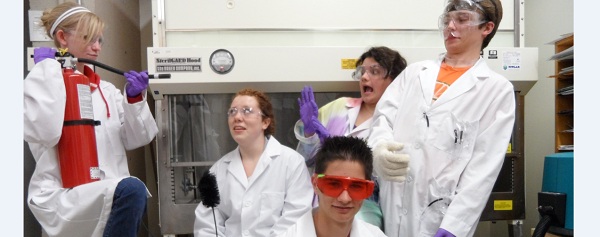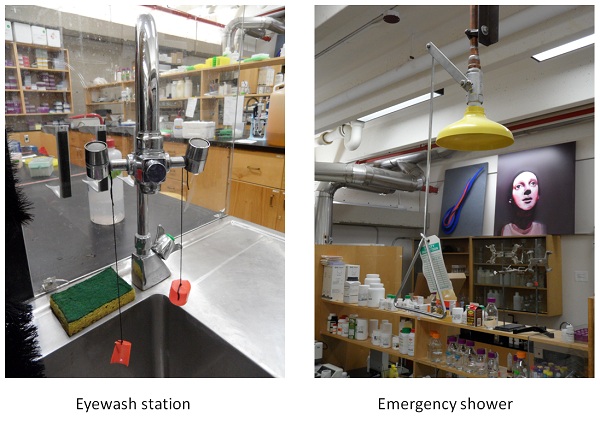Team:Lethbridge Canada/Safety
From 2012hs.igem.org
(→environmental safety?) |
(→4. Is there a local biosafety group, committee, or review board at your institution? If yes, what does your local biosafety group think about your project?) |
||
| (5 intermediate revisions not shown) | |||
| Line 26: | Line 26: | ||
!align="left"| | !align="left"| | ||
| | | | ||
| - | + | <center> <FONT SIZE=5>'''Biosafety'''</font></center> | |
| Line 51: | Line 51: | ||
[https://2012hs.igem.org/Main_Page Main page] | [https://2012hs.igem.org/Main_Page Main page] | ||
| - | |||
| - | |||
='''1. Would any of your project ideas raise safety issues in terms of:= | ='''1. Would any of your project ideas raise safety issues in terms of:= | ||
| - | |||
==researcher safety== | ==researcher safety== | ||
Because we are working with ''Escherichia coli'', there is an inherent risk of accidental contamination. To combat this issue, we made sure to wear protective gloves when handling the specimens, as well as wearing lab coats and goggles. We additionally promoted sterility by doing things such as "flaming" tubes that had specimens in them and disposing of waste appropriately. | Because we are working with ''Escherichia coli'', there is an inherent risk of accidental contamination. To combat this issue, we made sure to wear protective gloves when handling the specimens, as well as wearing lab coats and goggles. We additionally promoted sterility by doing things such as "flaming" tubes that had specimens in them and disposing of waste appropriately. | ||
| - | |||
==public safety== | ==public safety== | ||
To protect the public (in this case, the University students) from the potentially adverse effects of ''E. coli'', we diligently removed our gloves when we were outside of the lab. | To protect the public (in this case, the University students) from the potentially adverse effects of ''E. coli'', we diligently removed our gloves when we were outside of the lab. | ||
| - | |||
==environmental safety?== | ==environmental safety?== | ||
| - | Our project had very little to do with the environment; as such, we did not have to take too many precautions in this regard. | + | Our project had very little to do with the environment; as such, we did not have to take too many precautions in this regard. However, in case of accidental contamination through disposal, all cells were disposed of in bleach and all containers in contact with cells were washed with ethanol prior to going in the sink. |
| - | + | ||
| - | + | ||
| - | ='''2. Do any of the new BioBrick parts (or devices) that you made this year raise any safety issues? If yes, | + | ='''2. Do any of the new BioBrick parts (or devices) that you made this year raise any safety issues? If yes, did you document these issues in the Registry? How did you manage to handle the safety issue?'''= |
| - | did you document these issues in the Registry? How did you manage to handle the safety issue?'''= | + | |
None of the new BioBrick parts we created raised any safety issues; therefore, we did not deem it necessary to document anything in the Registry. | None of the new BioBrick parts we created raised any safety issues; therefore, we did not deem it necessary to document anything in the Registry. | ||
| Line 78: | Line 70: | ||
='''4. Is there a local biosafety group, committee, or review board at your institution? If yes, what does your local biosafety group think about your project?'''= | ='''4. Is there a local biosafety group, committee, or review board at your institution? If yes, what does your local biosafety group think about your project?'''= | ||
| - | There is no local biosafety organization at our institution; however, within our team, we had a group that dealt with biosafety issues. | + | There is no local biosafety organization at our institution; however, within our team, we had a group that dealt with biosafety issues. However since we did our lab work at the university we were required to follow guidlines put forth by Risk and Safty Services. |
==If no, which specific biosafety rules or guidelines do you have to consider in your country?== | ==If no, which specific biosafety rules or guidelines do you have to consider in your country?== | ||
| - | The Public Health Agency of Canada – Laboratory Biosafety and Biosecurity is the authority to whom we deferred. | + | The Public Health Agency of Canada – Laboratory Biosafety and Biosecurity is the authority to whom we deferred. |
='''5. Do you have any other ideas how to deal with safety issues that could be useful for future iGEM competitions? How could parts, devices and systems be made even safer through biosafety engineering?'''= | ='''5. Do you have any other ideas how to deal with safety issues that could be useful for future iGEM competitions? How could parts, devices and systems be made even safer through biosafety engineering?'''= | ||
Latest revision as of 07:05, 17 June 2012

| Home | The Team | The Project | Results | Human Practices | Notebook | Safety |
|---|
|
There are also emergency showers and eyewash stations to further protect anyone from any dangerous chemical which might come in contact with the skin. Being only high school students, we also always had to make sure at least one university student was in the lab with us at all times, like a buddy system. This was to minimize mistakes within the lab. It also helped to use all equipment properly. There was no eating or drinking in the lab. We also had a specific dress code when participating in lab activities. Closed toed shoes, long pants, goggles, gloves, and lab coats had to be worn at all times when in the lab. Frequent hand washing also became a trend. We also labeled every vial we used as to what DNA strand was in it and which media we used and our initials, to prevent others from having to guess what was in the container. Another thing that we learned was to take off one glove if we had to move locations (from one lab to another, etc,) to ensure nothing on our gloves such as harmful or corrosive chemicals got on any door handles.
1. Would any of your project ideas raise safety issues in terms of:researcher safetyBecause we are working with Escherichia coli, there is an inherent risk of accidental contamination. To combat this issue, we made sure to wear protective gloves when handling the specimens, as well as wearing lab coats and goggles. We additionally promoted sterility by doing things such as "flaming" tubes that had specimens in them and disposing of waste appropriately. public safetyTo protect the public (in this case, the University students) from the potentially adverse effects of E. coli, we diligently removed our gloves when we were outside of the lab. environmental safety?Our project had very little to do with the environment; as such, we did not have to take too many precautions in this regard. However, in case of accidental contamination through disposal, all cells were disposed of in bleach and all containers in contact with cells were washed with ethanol prior to going in the sink. 2. Do any of the new BioBrick parts (or devices) that you made this year raise any safety issues? If yes, did you document these issues in the Registry? How did you manage to handle the safety issue?None of the new BioBrick parts we created raised any safety issues; therefore, we did not deem it necessary to document anything in the Registry. 3. How could other teams learn from your experience?Other teams could learn how to avoid safety-related mishaps by ensuring that they wear gloves and remove them at appropriate times, as well as disposing of waste properly and sterilizing their work conditions. 4. Is there a local biosafety group, committee, or review board at your institution? If yes, what does your local biosafety group think about your project?There is no local biosafety organization at our institution; however, within our team, we had a group that dealt with biosafety issues. However since we did our lab work at the university we were required to follow guidlines put forth by Risk and Safty Services. If no, which specific biosafety rules or guidelines do you have to consider in your country?The Public Health Agency of Canada – Laboratory Biosafety and Biosecurity is the authority to whom we deferred. 5. Do you have any other ideas how to deal with safety issues that could be useful for future iGEM competitions? How could parts, devices and systems be made even safer through biosafety engineering?Effective communication among all members of the team ensures that safety issues are accounted for (for example, proper disposal of waste). Additionally, having safety training before being permitted to join the team is beneficial in the sense that it instills good lab-safety habits from the outset. Biosafety engineering could contribute to safety through, perhaps, creating a very specific "optimal zone" in which the bacteria can flourish (making them easier to deactivate, if necessary).
|
 "
"

